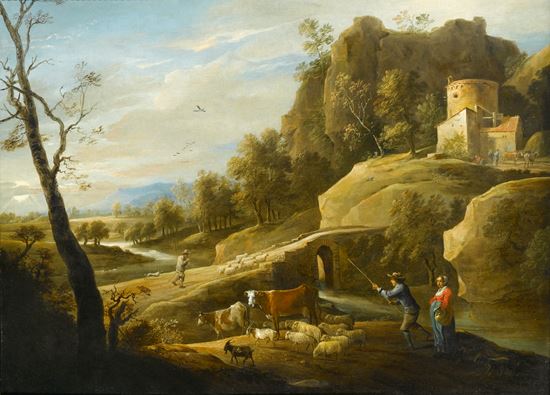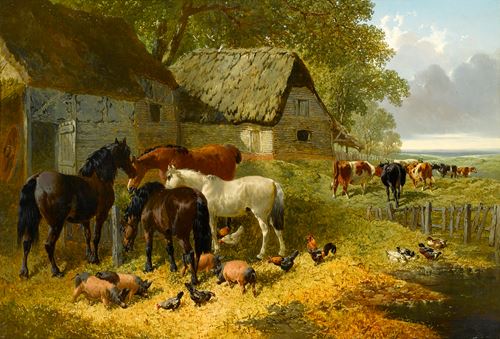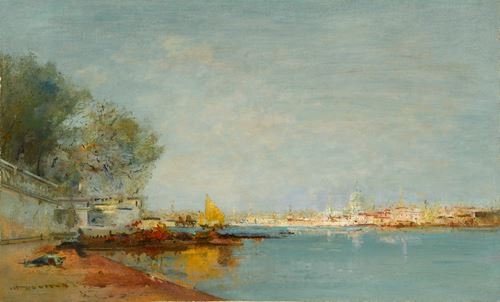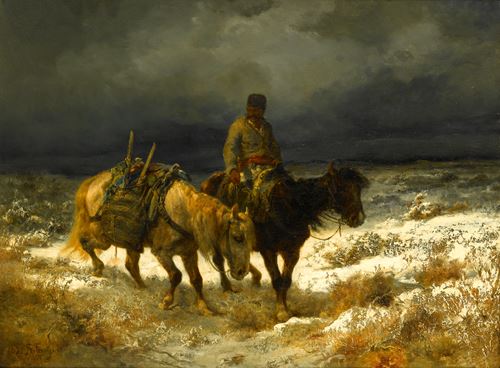avid Teniers II
(Antwerp 1610 - Brussels 1690)
Landscape with a Drover and his Herd by a River
signed on the rock ‘D.TENIERS’ (lower centre)
oil on canvas
67.9 x 92.7 cm (26¾ x 36½ in)
Scenes of Netherlandish country life were the dominant genre in David Teniers II’s varied and prolific career. This painting, dated by Dr. Margret Klinge to c. 1650, when Teniers was at the height of his powers, shows an Arcadian vision of rural existence. In the foreground a figure dressed in blue urges his herd of cattle, sheep and goats away from the river, whilst his dog lags behind. A woman in a red chemise waits patiently for the animals to move on, and in her arms she holds a jug filled with water. Beyond these figures, a shepherd follows his small flock of sheep over a bridge, whilst playing a tune on his pipe.
On the far side of the river, atop a small hill, is a slightly dilapidated building with a round tower, below which are more figures and cattle. The river leads the viewer’s eye away into the extensive landscape, where a mountain range and a walled city can be seen in the distance.
Sadly the building in the present work cannot be identified, in part because ‘During the 1640s and 1650s Teniers was apparently equally comfortable representing fantasy and reality in his depictions of country houses, so long as the effect created was sufficiently imposing’.¹ However, as his career progressed these buildings developed, from the rather dilapidated type seen in the present work, to the grander châteaux of the wealthy elite. In part this development may reflect the changes in Teniers’ own social status, as his success led to ennoblement and the funds to purchase the grand country manor of Drij Toren, a building that features in many of his paintings from the late 1650s onwards.²
Although Teniers’ landscapes were not intended to be topographically accurate, he did sketch extensively in the countryside, and as a result certain motifs reoccur throughout his work. In terms of the landscape, perhaps the most notable comparison to the present work is a painting in the Hermitage, which features the same bridge and building. The canvas of the Hermitage work is much smaller than our painting and as a result Teniers has compressed the scene, recognising that an extensive background landscape would in this case produce an ineffective composition, and instead the building dominates the picture frame. However, in both cases the building imbues the scene with an air of charming humble rusticity, providing a suitable backdrop for the idealised vision of rural life presented by Teniers.
Rural life of the type depicted in our painting was a subject that Teniers returned to throughout his career, a later example being the Royal Collection’s A Shepherd with his Flock in a Mountainous Landscape, which dates from the later part of the 1660s. Although there are obviously significant compositional differences between the two landscapes, the central subject, of a herd being driven through an extensive landscape is the same. Again, the drover holds his staff out over the herd, and this is a figure who reappears on numerous occasions in Teniers’ paintings, and can be seen in the lower left hand corner of a sheet of figure studies in the Louvre. The Royal Collection’s painting also has the familiar figures of a woman carrying water, and a piper. In each work Teniers uses one of his favourite compositional devices, as a single figure looks directly out at the viewer, engaging our attention. In his early work Teniers often lampooned and satirised peasants, in the long tradition of Pieter Brueghel the Elder (c. 1525-1569) or Adriaen Brouwer (c. 1605-1638). However, both our painting and the Royal Collection’s demonstrate how in the 1640s he began to idealise peasant life, and how this romanticising attitude remained for the rest of his career.
The painting has a particularly distinguished provenance having once been part of the noted collection of Alfred de Rothschild (1842-1918). Although he reluctantly worked as part of his family’s famous banking business, his interests and influence lay more in the administration of Britain’s public art collections, serving as a trustee of the National Gallery, and the Wallace Collection. He inherited thirty-eight, predominantly Dutch paintings, from his father, but by his death had built up a collection of over 200 works, which reflected ‘his taste for seventeenth-century Dutch masters, for Reynolds and Gainsborough’ and eighteenth-century French work.³ A significant portion of the collection was acquired from those of the Earl of Lonsdale and Lord Ashburton and it was hung in either Seamore Place in London or Halton in Buckinghamshire.
Teniers was born in Antwerp in 1610, the son of a painter and art dealer of the same name. His father painted small scale history paintings, and served as Teniers’ first teacher. Having served his apprenticeship he became a master of the Antwerp Guild of St. Luke in 1632-33, and in 1637 he joined Antwerp’s most famous artistic dynasty, by marrying Anna, daughter of Jan Breughel I.
From early in his career Teniers had excellent relationships with Antwerp’s art dealers, who greatly prized the genre paintings with which he quickly established his reputation. Although in this early work he absorbed a number of influences, ‘The most lasting impression, however, was made by Adriaen Brouwer’s (1605/6-1638) paintings of excited simple folk’.⁴ Brouwer spent the last period of his life in Antwerp and his pictures of the daily lives of peasants proved hugely influential for Teniers. However, where Brouwer’s figures tend to be very direct, expressive and animated, in contrast to these, Teniers’ paintings have a comparative calmness and composure. As Klinge says ‘his artistic individuality, unlike Brouwer’s, resides precisely in his almost still-life-like handling of figures and spaces’.⁵
Teniers soon became one of the most successful painters in Antwerp, and attracted several prestigious commissions. By the 1640s he had prospered to the extent that he was able to rent a large manor house, and in 1645 he became the Dean of the Guild of St. Luke. In 1647 he received his first commission from the newly appointed Governor of the Southern Netherlands, Archduke Leopold Wilhelm (1616-1662), and court painter and court painter four years later. This appointment meant he was responsible for expanding the Archduke’s picture collection, which saw him travelling to England. Teniers captured the collection in several gallery pictures as well as an illustrated catalogue Theatrum Pictorium (1660). After the Archduke left Brussels, Teniers stayed on as Court Painter to the new governor, Don Juan of Austria, and he also worked for Philip IV of Spain and Willem II of the Northern Netherlands. He continued to have great success and led an aristocratic lifestyle. He died in Brussels but his legacy continued to prove enormous influential to future generations of artists.
We are grateful to Dr. Margret Klinge who confirms this painting to be a work by David Teniers the Younger, dateable to c.1650. She will publish it in her forthcoming catalogue raisonné on the artist.
¹ Dreher, F. P., ‘The Artist as Seigneur: Chateaux and Their Proprietors in the Work of David Teniers II’, in The Art Bulletin, vol. 60, no. 4 (Dec., 1978), p.698.
² For a full discussion of Teniers social advancement and the depiction of châteaux in his art, see Dreher, pp. 682-703.
³ Conlin, J., ‘Butlers and Boardrooms: Alfred de Rothschild as Collector and Connoisseur’, in Rothschild Archive Annual Review (2006), pp. 28-29.
⁴ Klinge, M., ‘Introduction’ in David Teniers the Younger: Paintings, Drawings, exh.cat., Koninklijk Museum voor Schone Kunsten, Antwerp, May-Sept 1991, p.16.
⁵ Ibid., p. 18.
Alfred de Rothschild (1842-1918), Seamore Place, London;
thence by inheritance to his daughter, Almina, Countess of Carnarvon (1877-1969);
by whom sold, London, Christie’s, May 31, 1918, lot 156;
where purchased by Duits Ltd;
Jules van Goidsenhoven;
his posthumous sale, Galerie Fievez, Brussels, 17 December 1930, lot 791;
anonymous sale, London, Christie’s, November 16, 1973, lot 32;
with Cohen, London;
anonymous sale, Sotheby’s Mak van Waay, Amsterdam, October 31, 1977, lot 129A;
Kunstalon Francke, Baden-Baden, 1979;
on loan to the Portland Art Museum, Portland, Oregon, 1980 – 1982;
West German Private Collection;
anonymous sale, New York, Sotheby’s, January 17, 1985, lot 97 (unsold);
anonymous sale, Munich, Neumeister Kunstauktionen, September 23, 1992, lot 556.
To be published in Dr. Margret Klinge's forthcoming catalogue raisonné of the artist.
Exposition rétrospective du paysage flamand (XVIe, XVIIe,XVIIIe siècles), Brussels, Musées Royaux des Beaux-Arts de Belgique, 1926.
Scenes of Netherlandish country life were the dominant genre in David Teniers II’s varied and prolific career. This painting, dated by Dr. Margret Klinge to c. 1650, when Teniers was at the height of his powers, shows an Arcadian vision of rural existence. In the foreground a figure dressed in blue urges his herd of cattle, sheep and goats away from the river, whilst his dog lags behind. A woman in a red chemise waits patiently for the animals to move on, and in her arms she holds a jug filled with water. Beyond these figures, a shepherd follows his small flock of sheep over a bridge, whilst playing a tune on his pipe.
On the far side of the river, atop a small hill, is a slightly dilapidated building with a round tower, below which are more figures and cattle. The river leads the viewer’s eye away into the extensive landscape, where a mountain range and a walled city can be seen in the distance.
Sadly the building in the present work cannot be identified, in part because ‘During the 1640s and 1650s Teniers was apparently equally comfortable representing fantasy and reality in his depictions of country houses, so long as the effect created was sufficiently imposing’.¹ However, as his career progressed these buildings developed, from the rather dilapidated type seen in the present work, to the grander châteaux of the wealthy elite. In part this development may reflect the changes in Teniers’ own social status, as his success led to ennoblement and the funds to purchase the grand country manor of Drij Toren, a building that features in many of his paintings from the late 1650s onwards.²
Although Teniers’ landscapes were not intended to be topographically accurate, he did sketch extensively in the countryside, and as a result certain motifs reoccur throughout his work. In terms of the landscape, perhaps the most notable comparison to the present work is a painting in the Hermitage, which features the same bridge and building. The canvas of the Hermitage work is much smaller than our painting and as a result Teniers has compressed the scene, recognising that an extensive background landscape would in this case produce an ineffective composition, and instead the building dominates the picture frame. However, in both cases the building imbues the scene with an air of charming humble rusticity, providing a suitable backdrop for the idealised vision of rural life presented by Teniers.
Rural life of the type depicted in our painting was a subject that Teniers returned to throughout his career, a later example being the Royal Collection’s A Shepherd with his Flock in a Mountainous Landscape, which dates from the later part of the 1660s. Although there are obviously significant compositional differences between the two landscapes, the central subject, of a herd being driven through an extensive landscape is the same. Again, the drover holds his staff out over the herd, and this is a figure who reappears on numerous occasions in Teniers’ paintings, and can be seen in the lower left hand corner of a sheet of figure studies in the Louvre. The Royal Collection’s painting also has the familiar figures of a woman carrying water, and a piper. In each work Teniers uses one of his favourite compositional devices, as a single figure looks directly out at the viewer, engaging our attention. In his early work Teniers often lampooned and satirised peasants, in the long tradition of Pieter Brueghel the Elder (c. 1525-1569) or Adriaen Brouwer (c. 1605-1638). However, both our painting and the Royal Collection’s demonstrate how in the 1640s he began to idealise peasant life, and how this romanticising attitude remained for the rest of his career.
The painting has a particularly distinguished provenance having once been part of the noted collection of Alfred de Rothschild (1842-1918). Although he reluctantly worked as part of his family’s famous banking business, his interests and influence lay more in the administration of Britain’s public art collections, serving as a trustee of the National Gallery, and the Wallace Collection. He inherited thirty-eight, predominantly Dutch paintings, from his father, but by his death had built up a collection of over 200 works, which reflected ‘his taste for seventeenth-century Dutch masters, for Reynolds and Gainsborough’ and eighteenth-century French work.³ A significant portion of the collection was acquired from those of the Earl of Lonsdale and Lord Ashburton and it was hung in either Seamore Place in London or Halton in Buckinghamshire.
Teniers was born in Antwerp in 1610, the son of a painter and art dealer of the same name. His father painted small scale history paintings, and served as Teniers’ first teacher. Having served his apprenticeship he became a master of the Antwerp Guild of St. Luke in 1632-33, and in 1637 he joined Antwerp’s most famous artistic dynasty, by marrying Anna, daughter of Jan Breughel I.
From early in his career Teniers had excellent relationships with Antwerp’s art dealers, who greatly prized the genre paintings with which he quickly established his reputation. Although in this early work he absorbed a number of influences, ‘The most lasting impression, however, was made by Adriaen Brouwer’s (1605/6-1638) paintings of excited simple folk’.⁴ Brouwer spent the last period of his life in Antwerp and his pictures of the daily lives of peasants proved hugely influential for Teniers. However, where Brouwer’s figures tend to be very direct, expressive and animated, in contrast to these, Teniers’ paintings have a comparative calmness and composure. As Klinge says ‘his artistic individuality, unlike Brouwer’s, resides precisely in his almost still-life-like handling of figures and spaces’.⁵
Teniers soon became one of the most successful painters in Antwerp, and attracted several prestigious commissions. By the 1640s he had prospered to the extent that he was able to rent a large manor house, and in 1645 he became the Dean of the Guild of St. Luke. In 1647 he received his first commission from the newly appointed Governor of the Southern Netherlands, Archduke Leopold Wilhelm (1616-1662), and court painter and court painter four years later. This appointment meant he was responsible for expanding the Archduke’s picture collection, which saw him travelling to England. Teniers captured the collection in several gallery pictures as well as an illustrated catalogue Theatrum Pictorium (1660). After the Archduke left Brussels, Teniers stayed on as Court Painter to the new governor, Don Juan of Austria, and he also worked for Philip IV of Spain and Willem II of the Northern Netherlands. He continued to have great success and led an aristocratic lifestyle. He died in Brussels but his legacy continued to prove enormous influential to future generations of artists.
We are grateful to Dr. Margret Klinge who confirms this painting to be a work by David Teniers the Younger, dateable to c.1650. She will publish it in her forthcoming catalogue raisonné on the artist.
¹ Dreher, F. P., ‘The Artist as Seigneur: Chateaux and Their Proprietors in the Work of David Teniers II’, in The Art Bulletin, vol. 60, no. 4 (Dec., 1978), p.698.
² For a full discussion of Teniers social advancement and the depiction of châteaux in his art, see Dreher, pp. 682-703.
³ Conlin, J., ‘Butlers and Boardrooms: Alfred de Rothschild as Collector and Connoisseur’, in Rothschild Archive Annual Review (2006), pp. 28-29.
⁴ Klinge, M., ‘Introduction’ in David Teniers the Younger: Paintings, Drawings, exh.cat., Koninklijk Museum voor Schone Kunsten, Antwerp, May-Sept 1991, p.16.
⁵ Ibid., p. 18.
Alfred de Rothschild (1842-1918), Seamore Place, London;
thence by inheritance to his daughter, Almina, Countess of Carnarvon (1877-1969);
by whom sold, London, Christie’s, May 31, 1918, lot 156;
where purchased by Duits Ltd;
Jules van Goidsenhoven;
his posthumous sale, Galerie Fievez, Brussels, 17 December 1930, lot 791;
anonymous sale, London, Christie’s, November 16, 1973, lot 32;
with Cohen, London;
anonymous sale, Sotheby’s Mak van Waay, Amsterdam, October 31, 1977, lot 129A;
Kunstalon Francke, Baden-Baden, 1979;
on loan to the Portland Art Museum, Portland, Oregon, 1980 – 1982;
West German Private Collection;
anonymous sale, New York, Sotheby’s, January 17, 1985, lot 97 (unsold);
anonymous sale, Munich, Neumeister Kunstauktionen, September 23, 1992, lot 556.
To be published in Dr. Margret Klinge's forthcoming catalogue raisonné of the artist.
Exposition rétrospective du paysage flamand (XVIe, XVIIe,XVIIIe siècles), Brussels, Musées Royaux des Beaux-Arts de Belgique, 1926.




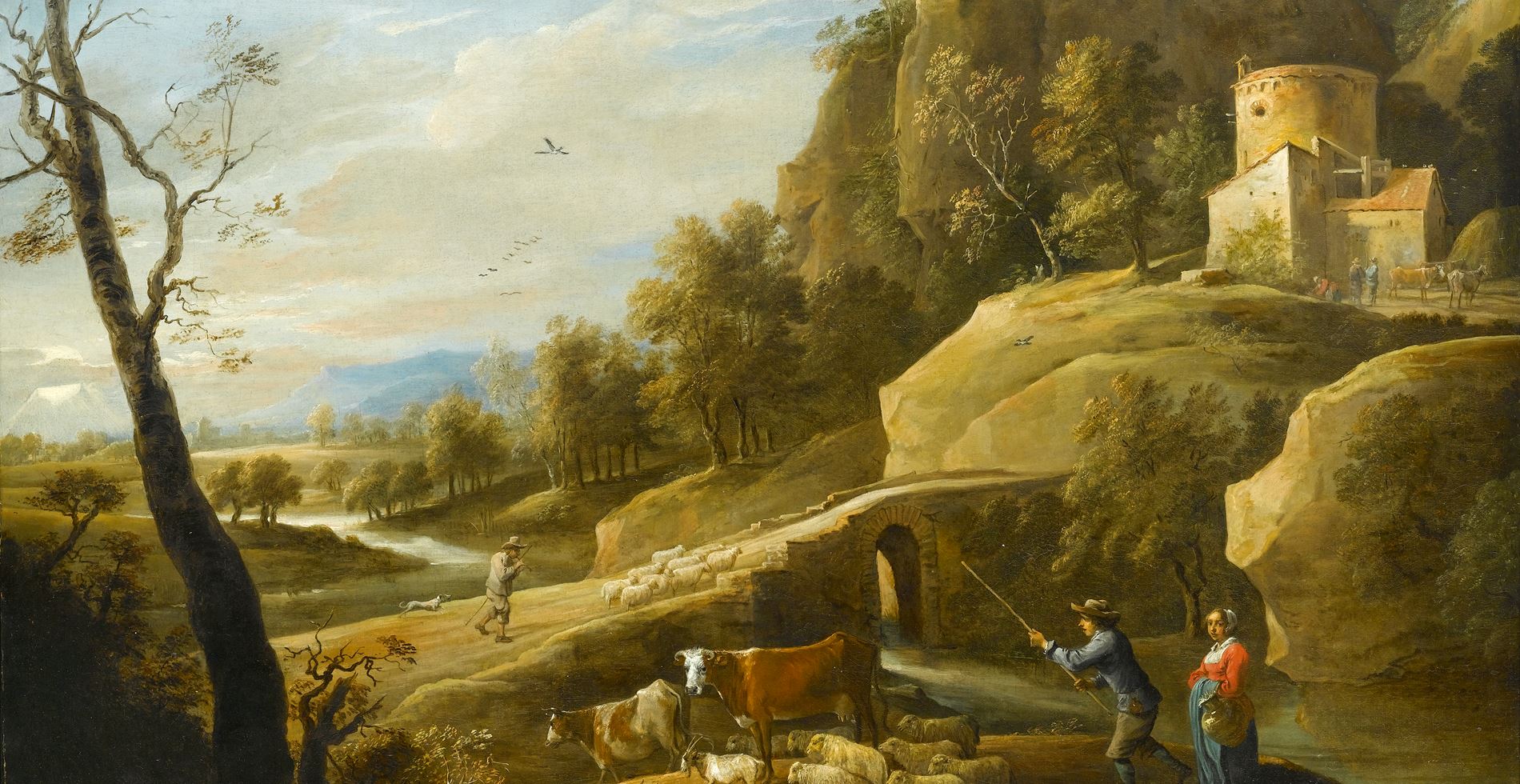
 contact
contact +44 20 7313 8040
+44 20 7313 8040


